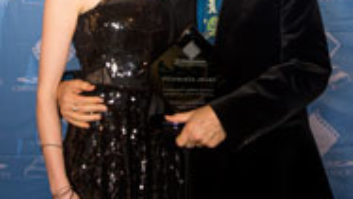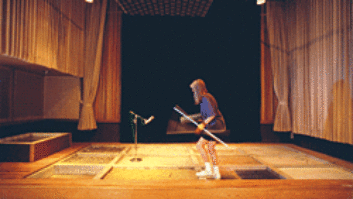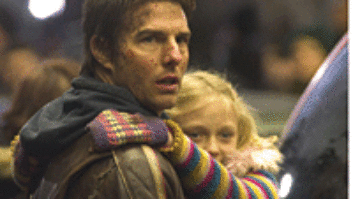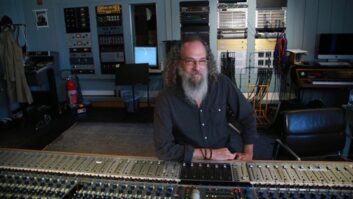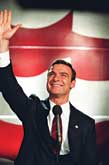
Photo: Ken Reagan
With roots planted firmly in the Cold War paranoia, John Frankenheimer’s superb 1962 film, The Manchurian Candidate, does not seem like a good prospect for a remake. But director Jonathan Demme — whose films have run the gamut from the brilliant Talking Heads concert movie, Stop Making Sense, to the Oscar-winning thriller The Silence of the Lambs, to his adventurous retooling of another great ’60s film, Charade (remade as The Truth About Charlie) — has succeeded in re-imagining The Manchurian Candidate as a spellbinding contemporary tale, with up-to-the-minute references to the current political climate and levels of deceit and evil that make the earlier drama seem positively quaint. In Demme’s film, the “Manchurian” in question has no ties to “Red China”; instead, it refers to a large, evil, Halliburton-like corporation, Manchurian Global. And the lead characters — one running for the vice presidency of the United States — are haunted by memories, dreams and questions about things that happened to their Army unit during the first Gulf War.
Demme’s riveting film is shot in a very straightforward, at times almost documentary, style. The sound design, however, is highly unconventional. Radios and televisions drone on in the background, talking about terrorism, disasters and the election. Police sirens blare in the distance, crowds sound tense and nervous, and inside the mind of lead character Ben Marco (Denzel Washington), the sounds of city life merge with his increasing paranoia and flashes of recovered memory into a horrifying and dissonant roar that seems to be driving him mad.

Paul Urmson
“Jonathan wanted the film to be hyper-real,” notes supervising sound editor Paul Urmson, who works out of C5 Sound in New York. “He wanted it to be a modern-day, very post-9/11 environment, so he constantly wanted things in the background that sounded ‘state-of-emergency’: sirens, cop radios, helicopters. The first challenge was to get that sense throughout the whole movie. We wanted the film to have a very organic background, with a lot of real elements but played in unusual ways.
“Jonathan also really wanted to play with the psychology of all these guys [from the Gulf War] and how they’d been screwed with mentally,” Urmson continues. “So one of the key points was to show Denzel’s character coming unglued through the course of the movie, and as that’s happening, more and more sound comes into play. Jonathan wanted him to be hypersensitive to sound, so there’s always source music playing from another apartment and constant newscasts and media — camera shutters. Everything is really building on him, and he’s becoming more paranoid as he’s discovering that what he thought was completely ridiculous is actually real. The overall approach to the sound was to build, build, build in layers.”
The film was shot in the fall of 2003, followed by the arduous task of editing and doing the early sound work at Demme’s Nyack, N.Y.-based facility in the winter of 2004. “I set up a 5.1 room with Pro Tools|HD and a Control|24 and started doing design work on a few key scenes,” Urmson notes. “I also use Logic Audio quite a bit for design because there are so many cool AudioUnits plug-ins available.
“It was so beneficial to be [at Demme’s studio] with the picture department for three months. I did tons of temp mixes. I’d feed them back to the [film editors] and they’d look at it on their Avids; there was lots of back and forth. Jonathan doesn’t have conservative ideas about sound at all, and he doesn’t care compartmentally whether it’s effects or music or textural. It’s all part of the sound to him. So we ended up working very closely with [music composer] Rachel Portman. The music and effects are blended in very interesting ways.”

Tom Fleischman
“There are a lot of things that Rachel Portman did that don’t sound like score, per se, that are used more like effects — great low tones on celli and basses,” adds re-recording mixer Tom Fleischman, who did his work at Soundtrack F/T (Film & Television) in Manhattan on a Euphonix System 5. “There were scenes where she wrote these long pads that were constantly shifting clusters of those instruments.
Then Wyclef Jean came in and did these tracks where he was just plunking around on the guitar. It was not melodic at all, but it added a lot. There were several instances when I listened to these guitar tracks by themselves and thought, ‘This is never going to work.’ But when they were put to the rest of the track, they added a whole new insane dimension to the feel of the scenes. Later, as we went back in and saw how well the guitar was working with the score, they added some more with an electric bass. And then there’s all this source music coming out all over the place that’s piled on top, especially toward the end, where [Denzel’s] going nuts and running around the city. That was all multilayered.” Urmson notes that he also added some synth textures here and there, and that he worked closely with Portman’s music editor, Suzana Peric, “who also concocted some great things, too.”
The ongoing news reports, which drift in and out of scenes like an unnerving audio hallucination, “came to me mostly as ADR tracks,” Fleischman says. “They spent quite a bit of time recording a number of different real newscasters. Jonathan wrote pretty much all the lines himself and then, because he wanted it be as fresh as possible, he kept writing new lines. If something happened in the news while we were mixing, they’d get the newscasters back in [the studio] and record a bunch of lines about it. And literally, right up until the last days of the mix, those lines were being changed.” Deborah Wallach was the ADR supervisor and Jac Rubenstein served as the dialog editor.
One set of particularly unnerving scenes has Washington’s character visiting the lab of a German scientist named Delp (portrayed chillingly by Bruno Ganz) in search of answers about his disturbing dreams and memories. The lab backgrounds are a mysterious, irritating scratching and scraping, like some awful metallic rubbing, mixed with what sounds like bird or animal screeches. It’s not until near the end of the film that we learn that caged lab monkeys made that hideous noise.
“The monkeys were another texture we wanted to play with,” Urmson says, “because the idea is they’ve all been experimented on — the soldiers and the monkeys; that’s that metaphor. For some of that [sound], we went to the [C5] Foley department [in northern New Jersey] and asked for the scraping on metal and cage rattles so we could make a background. I also played a lot with monkey recordings I had done awhile back in Los Angeles and there was also some really good production material — there actually were monkeys on the set and I used some of that.” Steven Visscher was the supervising Foley editor. The production recordist/mixer was multi-Oscar — winner Chris Newman.
Another challenging scene was the graphic drowning murder of a kayaker that occurs toward the end of the film. Here, the approach was shocking realism.
According to Urmson, “I had a friend of mine, [noted L.A. effects recordist] Eric Potter, go up to Eugene, Oregon, with a kayak. He banged the hell out of it and did some great recording. I gave that to my effects editor, Wyatt Sprague, and he cut that material in with some additional effects that he had recorded. Meanwhile, I worked on a lot of the underwater vocals and processing. In Logic, I used these bizarre filter plug-ins from Pluggo, which are made by Cycling ’74. There’s one called Harmonic Dreamz that you can use as a fast modulation filter so you get this sort of bubbly underwater sound.
“I also had some other recording of movement and bubbles that I did with an Audio-Technica mic with a condom over it. You put it in your bathtub, stick your head under there and start screaming. It works great every time. Then Foley made a lake and did all this nice water detail and paddling noises. It meshed together nicely.”
In general, Urmson says, when they first started working on the soundtrack, it was quite dense. The temps, then, accomplished mostly on Pro Tools Control|24, became an exercise in weeding out. “I was able to give those elements to Tom [Fleischman],” Urmanson notes, “and he’s so amazing; just an incredible mixer. He brings it to a whole other level.”
Fleischman, meanwhile, is generous in crediting Urmson and others for delivering such creative effects to the stage and notes that Demme was an active participant in every stage of the soundtrack’s construction. “The ambiences were very carefully designed, and Jonathan would often be there picking these pieces of sound that he wanted to hear,” Fleischman says. “There’s a scene where [Marco] is going to [his former army mate] Melvin’s apartment, and that hallway has like 14 different sounds happening in it. It’s really wild.”
“He’s extremely creative,” Urmson says of the director. “He’s so into the characters. Sometimes the sound he’s looking for is something more psychological than literal. And he’s also looking for the dramatic in anything. He would ask us to do things that might be counter to your initial intuition, like, ‘Let’s make that truck-by gigantic, but let’s make this gun-cock small. But the door-open is huge and it’ll scare the shit out of everyone when it happens!’ He likes to keep everyone guessing.”
Including the sound crew? “Oh, absolutely,” he says with a laugh.
Blair Jackson is Mix‘s senior editor.
